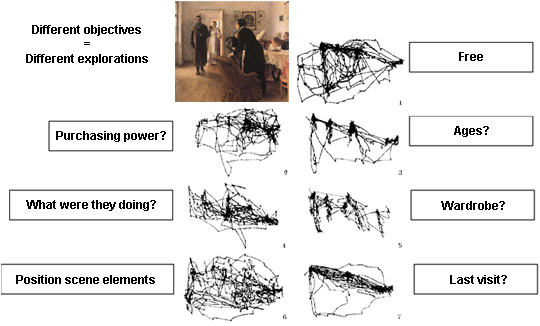Many of us believe we are not visually trained. We believe our eyes move all around the painting, not simply where the artist "leads" us. But even if your mind believes you are not picking up on these nuances in form, your eyes are experiencing another reaction altogether (and you're right about your eyes moving all over the painting!).
Enter, (1) eye-tracking software from the science of Usability (UX). Interaction designers, user experience developers, and marketing executives primarily use this technology to prove the effectiveness of their layouts, programmed interactions, and advertisements.
As you can see in the first video, the eye movement was quick and sporadic, often bouncing around the page from one corner to the next. This sporadic eye movement is natural when viewers first glance at a new screen (or painting). The mind tends to send the eyes off to find objects of interest, and then lingers on those objects it finds compelling. Our eyes see much more information than our brain registers into memory. So even if you think you didn't notice the form of the painting above, I can guarantee your eyes were focused on specific sections just like the rest of us. The difference now, is whether we take the time to think about what our eyes are looking at. In essence, we can train our brains to recognize the subtle visual cues.
 |
| Notice the hottest spots are people's faces? We tend to look for people's faces, in order to connect. |
Here is (2) one video explaining the different eye-tracking input technologies out there and how they may help create better assistive technology experiences. Apparently one company, LC Technologies, is located in Virginia!
 |
| An interesting experiment into what we see when given objectives. Found in this article. |
Another cool prospect in this field is the Eye Tribe Tracker, an interactive eye-tracking device. (3) This video shows a prototype of what could be developed in the future (not all features are available currently). This takes the eye-tracking information from above, and creates an interaction with our existing devices by following our eyes. The science behind the "choices" our eyes make would depend on the length of time a user looked at one particular spot on the screen. It is really an innovative design for user interfaces!
It's all really fascinating stuff! Let me know if you have any questions.
-Becca


Becca,
ReplyDeleteYou are right when you say this is really fascinating stuff. The videos were really cool and informative. I have a galaxy phone so have touched on the very basics of what you are trying to point out. All could think of where all the great uses of this technology in such a wide variety of environments. When I was teaching, we had a nonverbal student (with a few other learning needs) who had to type into computer to communicate. I think about how this would have helped him in all of his classes, not just to verbalize thoughts, but to take notes, read assignments,etc... It reminds me of Stephen Hawking and his computer that pretty much does everything for him and how it could help other ALS patients. As a busy mom, I would also love to just be able to look at something to control it. Multi-tasking at its finest. Thanks for sharing all of this.
SO COOL.
ReplyDeleteThe first video where people didn't notice the sale is especially interesting. There are so many things I'd love to test out with this eye-tracking technology… promotional items placement on drive-thru menus, CNN with it's tickers, fast-paced sporting events on TV, etc...
I wonder how marketing people / advertisers who put up alternating ads in Times Square, Las Vegas, and other places use this information. The ads are up for a short amount of time in an already visually overwhelming area. I bet they use this kind of technology to get the most bang for their money.
Really cool post!
ReplyDeleteDuring the exercise in class, I felt like most of the time my eyes do notice the intentional lines in paintings, as I have heard of this concept before. What I didn't know is that there is an interactive eye tracking device-- it never ceases to amaze me the things we can do with technology today. Great find!!
Really cool post!
ReplyDeleteDuring the exercise in class, I felt like most of the time my eyes do notice the intentional lines in paintings, as I have heard of this concept before. What I didn't know is that there is an interactive eye tracking device-- it never ceases to amaze me the things we can do with technology today. Great find!!
I've heard of this technology and I am excited to see how it can be used in various fields such as graphic design, marketing, or education.
ReplyDeleteReally neat post! I feel like pictures and images that have very bold outlines appeal to my sense, because it draws my attention to the object more quickly than light, colored, non-bordered figure. this technology seems like a really neat way to cater to that trait!
ReplyDelete